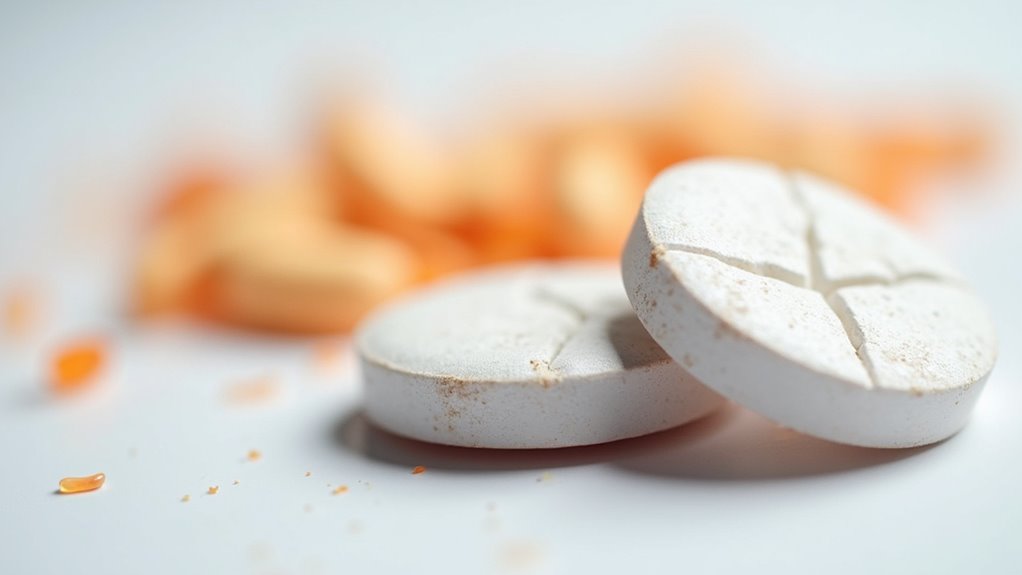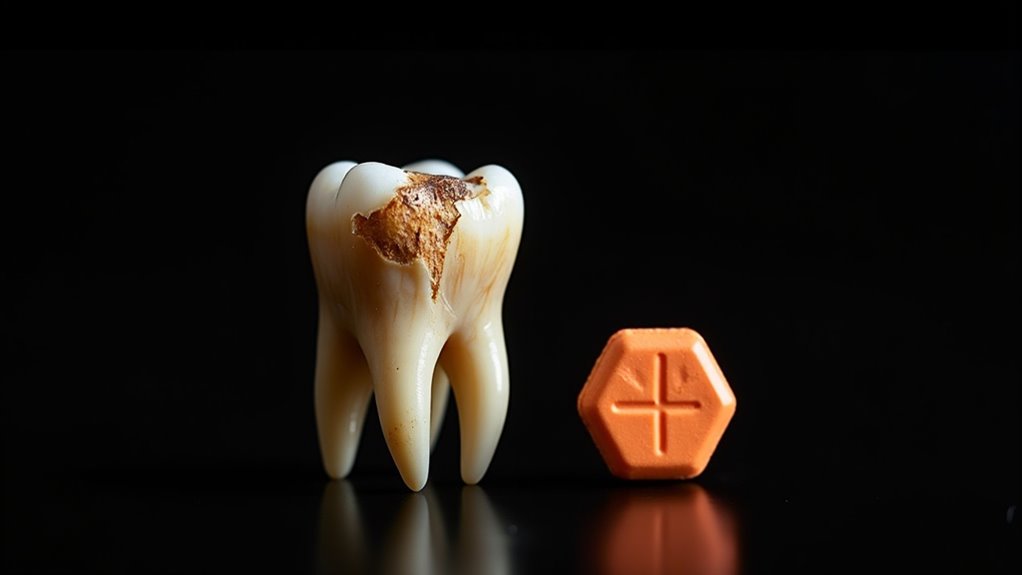Quality concerns with Suboxone films can arise from manufacturing challenges that affect batch consistency and content uniformity. Your medication’s safety depends on strict production controls for temperature, pressure, and ingredient ratios. Recent FDA alerts highlight potential dental risks from the acidic nature of sublingual films, which may accelerate tooth erosion. You’ll want to monitor for signs like increased tooth sensitivity or unusual staining. Understanding these quality factors can help protect your long-term treatment success.
Understanding the Dental Health Risks of Suboxone Films

While Suboxone films provide essential treatment for opioid use disorder, they’ve emerged as a significant concern for dental health following the FDA’s 2022 safety communication. Studies show that frequent daily dosing can significantly increase dental problems. The sublingual films’ acidic nature and prolonged contact with teeth during optimal dosing protocols can accelerate enamel erosion, leading to rapid decay and potential tooth loss.
Your risk increases substantially if you have existing dental conditions or delayed care during active addiction. The impact on existing dental conditions can be severe, with documented cases of “rampant caries” affecting multiple teeth simultaneously. The buprenorphine/naloxone combination‘s dissolution across your entire mouth can trigger soft tissue infections and abscesses. Understanding these risks is imperative, as dental complications have been reported even in patients with previously good oral health. To minimize these risks, patients should wait at least one hour before brushing teeth after taking their Suboxone dose.
Key Manufacturing and Quality Control Issues

Manufacturing consistency for Suboxone presents significant challenges due to complex polymer matrices and precise active ingredient ratios that require strict process control parameters. You’ll find that batch-to-batch uniformity depends heavily on maintaining precise temperature, pressure, and moisture content specifications during production, with even minor deviations potentially affecting drug release profiles. The medication’s two dosage strengths must be carefully differentiated throughout the manufacturing process to prevent mix-ups. Strategic partnerships with reliable API suppliers are essential since fluctuating ingredient availability can severely impact production consistency and timelines.
Quality control protocols must include thorough batch testing for content uniformity, dissolution rates, and stability metrics to guarantee each production run meets FDA standards for safety and efficacy. Due to these rigorous requirements, quality control issues are among the most common reasons for drug shortages in pharmaceutical manufacturing.
Manufacturing Consistency Challenges
Numerous manufacturing consistency challenges have emerged in Suboxone brand production, spanning quality control failures, production line disruptions, and process validation deficiencies. Production disruptions impacting supply have resulted from multiple factors, including raw material sourcing challenges and unvalidated process controls during scale-up operations.
Key manufacturing consistency issues you’ll encounter include:
- Fluctuations in active pharmaceutical ingredient quality affecting sublingual film formulation
- Unresolved deficiencies in critical process parameters and commercial equipment specifications
- Content uniformity testing gaps compromising batch-to-batch consistency
- Complex manufacturing processes creating scale-up challenges and product variability
These manufacturing challenges directly impact product quality and availability, requiring bolstered oversight of production processes and stricter adherence to validation protocols across all manufacturing stages.
Batch Testing Protocols
Building upon established manufacturing protocols, extensive batch testing serves as a cornerstone of Suboxone’s quality control framework. You’ll find that initial stability testing of the primary three commercial batches is pivotal for determining product shelf life and consistency.
The analytical method validation process employs LC-MS/MS technology to precisely measure plasma concentrations of active ingredients and metabolites. Unlike standard induction methods that take days, QuickStart transition protocols have demonstrated complete effectiveness in under an hour while maintaining product quality standards.
To guarantee regulatory compliance, manufacturers must provide thorough batch-specific documentation, including manufacturing dates and unique batch numbers. You’re protected by rigorous impurity testing protocols that utilize control standards for different sample matrices.
Storage stability validation confirms product integrity for up to 90 days, while long-term stability studies track drug and metabolite consistency. Quality assurance oversight incorporates both in-house controls and third-party reference materials to verify test accuracy.
Warning Signs of Product-Related Tooth Damage

Vigilant monitoring of dental health becomes essential for Suboxone users, as research has identified specific warning signs of medication-related tooth damage. Early detection through proper oral hygiene techniques can help prevent severe complications, while addressing economic barriers remains pivotal for maintaining consistent dental care.
Regular dental checkups and proper oral care are crucial safeguards for Suboxone patients to prevent and detect medication-induced tooth damage early.
The sublingual film formulation requires extended contact with mouth tissues, significantly increasing risk compared to tablet versions. The medication’s acidic 3.4 pH directly contributes to enamel erosion when dissolved, making proper administration crucial for minimizing damage.
Watch for these documented indicators of potential Suboxone-related dental issues:
- Increased tooth sensitivity or pain during biting and chewing, particularly if you didn’t experience these symptoms before treatment
- Visible discoloration or unusual staining on tooth surfaces where the medication makes contact
- Persistent bad breath that doesn’t resolve with regular brushing, suggesting bacterial buildup
- Loose or sore teeth emerging shortly after starting treatment, especially if you’ve had no prior dental problems
Investigating Your Medication’s Ph Levels
Understanding the pH levels of your Suboxone medication is essential for managing oral health risks, as commercial formulations typically maintain an acidic pH range between 3.5 and 5.5—significantly lower than the natural mouth pH of 6.2-7.0.
Quality control testing shows that proper pH levels should fall between 4.0 and 4.8. To protect your dental health, you’ll need to monitor how your specific formulation affects your oral pH. Sublingual administration methods are most commonly associated with dental complications. While medication interactions can influence pH levels, proper patient education focuses on identifying warning signs of enamel erosion. You can request pH testing of your prescribed formulation, particularly if you’re using compounded solutions. These typically maintain a less acidic pH of 5.9-6.4.
Pay attention to storage conditions, as extreme temperatures may alter your medication’s pH stability. If you notice increased tooth sensitivity or decay, consult your healthcare provider about switching to formulations with higher pH levels.
Treatment Options and Protective Measures
When evaluating treatment alternatives to Suboxone, several FDA-approved medications offer distinct advantages based on individual patient needs. Your healthcare provider can help determine the most appropriate option while considering compliance and adherence factors.
Key treatment alternatives include:
- Zubsolv tablets, offering improved bioavailability and potentially lower opioid content per dose
- Methadone through specialized clinics, requiring strict monitoring protocols
- Naltrexone/Vivitrol for post-stabilization, necessitating complete detox beforehand
- Combination therapies pairing medications with behavioral support
These withdrawal management strategies often incorporate protective measures like regular urine testing, naloxone co-prescribing, and structured tapering protocols. Medication-assisted treatment has shown the highest success rates for opioid addiction recovery. Carefully planned gradual dose reduction helps minimize withdrawal symptoms during treatment transitions. You’ll need frequent check-ins with your provider to guarantee proper dosing and minimize diversion risks. Community health centers and SAMHSA’s 24/7 helpline can connect you with affordable treatment options and support services. Generic forms of pure buprenorphine remain available as an alternative for patients who cannot tolerate naloxone.
Legal Rights and Patient Advocacy
Patients receiving Suboxone treatment maintain specific legal protections under federal and state laws, extending beyond basic healthcare rights. The ADA prohibits discrimination based on your medication-assisted treatment status, safeguarding you from workplace termination, housing denial, or healthcare refusal.
Evidence-based treatment has proven highly effective at reducing overdose deaths and supporting long-term recovery. Your medication access rights have expanded with the removal of the X-waiver requirement for buprenorphine prescriptions, while EMTALA mandates hospitals must provide stabilization treatment regardless of insurance status. If you encounter discrimination, you can access advocacy resources through the Legal Action Center’s MAT toolkit, which provides templates for demand letters and complaint filing procedures.
For workplace issues, you’re entitled to file EEOC complaints, and state laws may offer additional safeguards. Document all discriminatory incidents and consider partnering with legal aid organizations for support. Employers must provide reasonable accommodations for employees taking prescribed Suboxone unless it creates an undue hardship.
Regulatory Updates and Safety Alerts
Recent regulatory updates have highlighted significant safety concerns regarding transmucosal buprenorphine products, particularly focusing on dental complications from oral dissolution. The FDA’s October 2024 warning has led to changes in prescription patterns and dental hygiene recommendations for patients using these medications.
Key regulatory developments include:
- Implementation of mandatory dental evaluations before initiating transmucosal buprenorphine treatment
- Updated administration protocols requiring thorough mouth rinsing after each dose
- Amplified monitoring requirements for dental health during ongoing treatment
- Introduction of alternative formulation options for patients with pre-existing dental conditions
These changes reflect the FDA’s response to adverse event reports linking buprenorphine dissolution to serious dental issues, including enamel erosion, tooth decay, and oral infections. Healthcare providers must now carefully weigh the benefits of transmucosal formulations against potential dental risks when prescribing these medications.
Alternative Formulations and Treatment Choices
While Suboxone films face quality concerns, you’ll find several viable alternatives with distinct pharmaceutical profiles, including Zubsolv’s optimized pH formulation and Belbuca’s augmented buccal absorption technology.
You can consider extended-release options like Sublocade, which utilizes advanced depot technology to maintain consistent drug levels through monthly administration. These alternatives incorporate protective coating technologies and varied delivery mechanisms that may offer improved stability and bioavailability compared to traditional sublingual films.
Treatment Options Beyond Films
Three major advancements in buprenorphine treatment have emerged beyond traditional Suboxone films: injectable formulations, rapid induction protocols, and telemedicine-enabled access.
You’ll find these key improvements in treatment options:
- Injectable formulations like Sublocade and Brixadi now offer multiple injection sites, including thigh, buttock, and upper arm locations
- Rapid induction protocols have reduced the traditional 7-day waiting period to just one hour of observation after an initial dose
- Telemedicine-driven treatment access, effective January 2025, eliminates the need for in-person visits
- Long-acting formulations provide consistent dosing while reducing diversion risks compared to daily films
These alternatives demonstrate comparable safety profiles to traditional films, with retention rates for rapid induction protocols reaching 67.1% versus 59.6% for standard approaches.
Exploring Different Ph Levels
Understanding pH stability proves critical in Suboxone’s therapeutic effectiveness, with commercial formulations maintaining strict pH ranges between 3.4 and 5.4 for favorable drug performance. pH variability in saliva can significantly impact your medication’s absorption, with both acidic and alkaline conditions reducing buprenorphine bioavailability by 14-16%.
You’ll want to be cautious about what you drink before taking Suboxone, as acidic beverages like Sprite can decrease naloxone absorption by 30-36%. The impact of oral pH on absorption becomes especially concerning when you consume pH-altering liquids before administration.
While neonatal formulations use pH 5.4 for safety, standard products dissolve to pH 3.4 in aqueous solutions. To maintain ideal therapeutic benefits, you should avoid drinking anything that could alter your mouth’s natural pH before taking your medication.
Protective Coating Technologies
Since Suboxone’s shift from tablets to films in the US market, protective coating technologies have progressed substantially to improve treatment efficacy and prevent misuse. These innovations focus on tamper resistance and coating integrity while ensuring essential drug delivery.
Key developments in protective coating technologies include:
- Specialized sublingual film coatings that dissolve in 5-10 minutes, enhancing bioavailability
- Adhesive buccal formulations that maintain prolonged contact for consistent absorption
- Protective barriers that prevent unintended naloxone release while deterring injection attempts
- Advanced coating methods that control dissolution rates and therapeutic outcomes
You’ll find these coating technologies particularly necessary when considering treatment options, as they directly impact drug absorption and effectiveness. Different formulations may affect your adherence to treatment, making it vital to discuss specific coating properties with your healthcare provider.
Long-Term Health Impact Assessment
Thorough research on Suboxone’s long-term health implications reveals a complex balance of benefits and risks. While you’ll experience significant reductions in overdose risk and opioid-related hospitalizations by up to 40% with continuous treatment, you should be aware of potential physiological effects. Hormonal disruptions may develop, requiring endocrinological monitoring if you’re in a high-risk category.
You’ll need to weigh these considerations against the proven benefits: over 40% of patients achieve consistently low opioid use post-intervention, with 18.6% reaching near-zero use after one year. However, you might encounter chronic side effects like weight changes, sleep disturbances, and constipation. Your healthcare provider should implement individualized dosing plans and regular monitoring to optimize your treatment outcomes while minimizing adverse effects.
Monitoring and Reporting Adverse Effects
Effective monitoring of Suboxone’s adverse effects requires a systematic approach to identify and track both common and severe reactions. Your healthcare provider will implement exhaustive medication adherence tracking while teaching you proper symptom recognition training to guarantee safe treatment.
Key monitoring protocols you’ll need to follow include:
- Regular assessment of withdrawal symptoms and potential overdose signs, particularly monitoring your breathing rate and alertness level
- Scheduled dental examinations to check for tooth decay and oral health complications
- Documentation of any adverse reactions like dizziness, chest pain, or severe digestive issues
- Immediate reporting of serious symptoms through FDA’s MedWatch system or directly to your healthcare provider
You’ll need to maintain close communication with your healthcare team and promptly report any concerning symptoms, especially those affecting your breathing or heart function.
Frequently Asked Questions
Can Suboxone Film Strips Interact Negatively With Specific Dental Materials or Fillings?
Yes, Suboxone films can tremendously impact your dental materials due to their acidic nature when dissolved. They pose dental adhesive compatibility issues, particularly with composite resin fillings, potentially weakening bonds and causing premature failure.
You’ll also face enamel discoloration risk and accelerated degradation of ceramic restorations. The films’ pH level below 5.5 creates an environment that can compromise both natural tooth structure and restorative materials over time.
How Do Different Storage Conditions Affect the Chemical Stability of Suboxone?
Your Suboxone’s chemical stability depends heavily on storage conditions. Glass containers provide the best protection, maintaining over 90% potency for 180 days regardless of temperature variability.
However, plastic storage can lead to significant degradation, with up to 80% loss at room temperature. You’ll achieve ideal stability by storing in glass under refrigerated conditions. While humidity fluctuations are less critical, protecting from light and using proper containers is essential for maintaining drug effectiveness.
Are There Batch-Specific Variations in Dissolution Time Between Different Manufacturers?
You’ll find notable dissolution rate variations between different manufacturers’ batches of buprenorphine/naloxone products. Studies show that films consistently dissolve in 5-6.6 minutes, while tablets range from 7-12.4 minutes.
Manufacturer consistency varies, with ZUBSOLV demonstrating 5-minute dissolution times compared to Suboxone’s 12.5 minutes. These differences are attributed to formulation-specific factors, including tablet composition and manufacturing processes. Regular quality control testing helps maintain acceptable batch-to-batch consistency.
Can Genetic Factors Influence Individual Susceptibility to Suboxone-Related Dental Complications?
Yes, your individual genetic profile can markedly influence your susceptibility to Suboxone-related dental complications. Your genes affect key factors like salivary composition, enamel structure, and oral microbiome composition. Variations in genes controlling saliva production, pH buffering capacity, and immune responses can make you more vulnerable to acid-related damage.
Furthermore, genetic differences in drug metabolism pathways may impact how long Suboxone remains in contact with your teeth.
Does Combining Suboxone With Certain Beverages Increase Its Acidic Effects?
Yes, consuming carbonated beverages or acidic juices while taking Suboxone drastically increases the acidic effects on your oral health.
When you combine Suboxone (pH 3.4) with drinks like sodas (pH 3.0-3.3) or citrus juices, you’re creating a more aggressive acidic environment in your mouth. This combination prolongs enamel exposure to harmful pH levels below 5.5, accelerating tooth demineralization.
You’ll want to avoid these beverages during Suboxone administration to protect your dental health.

